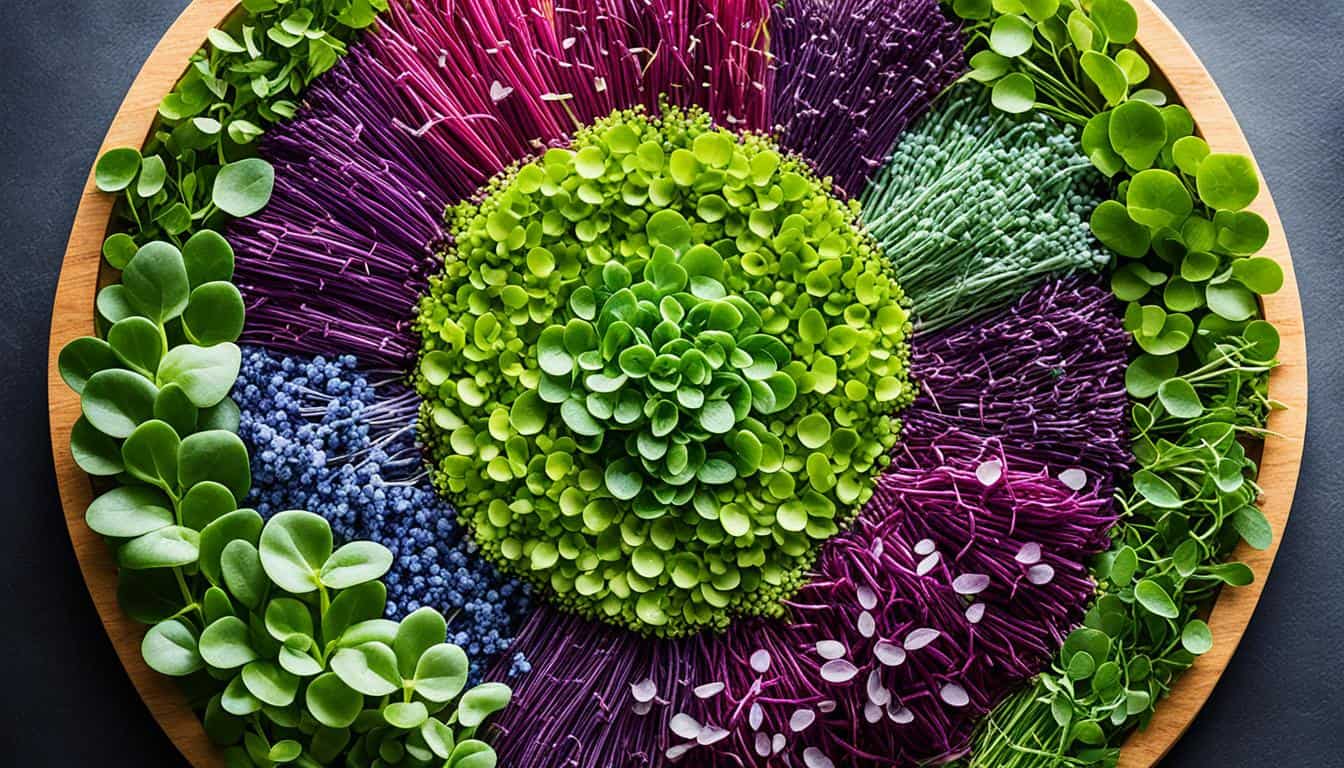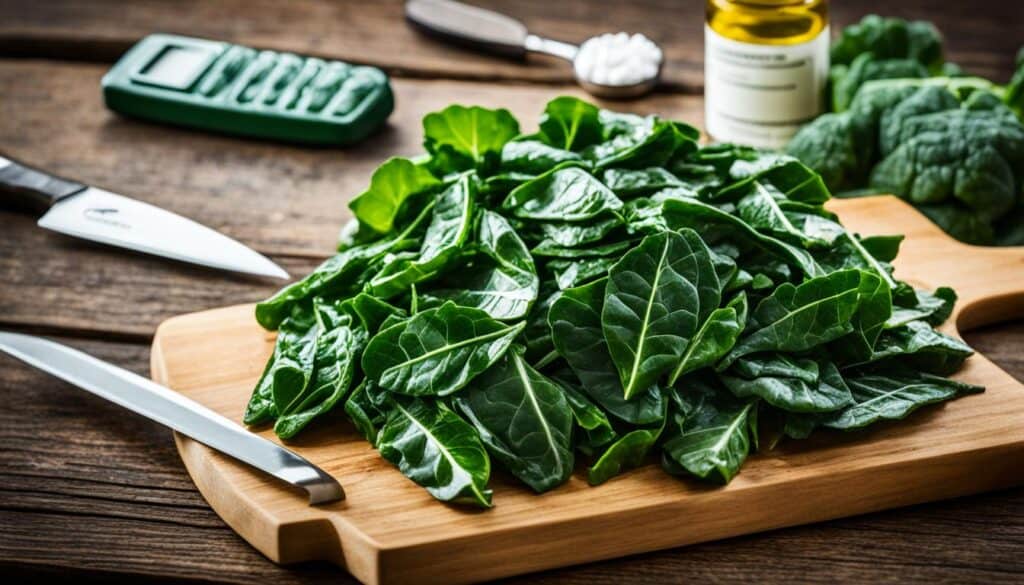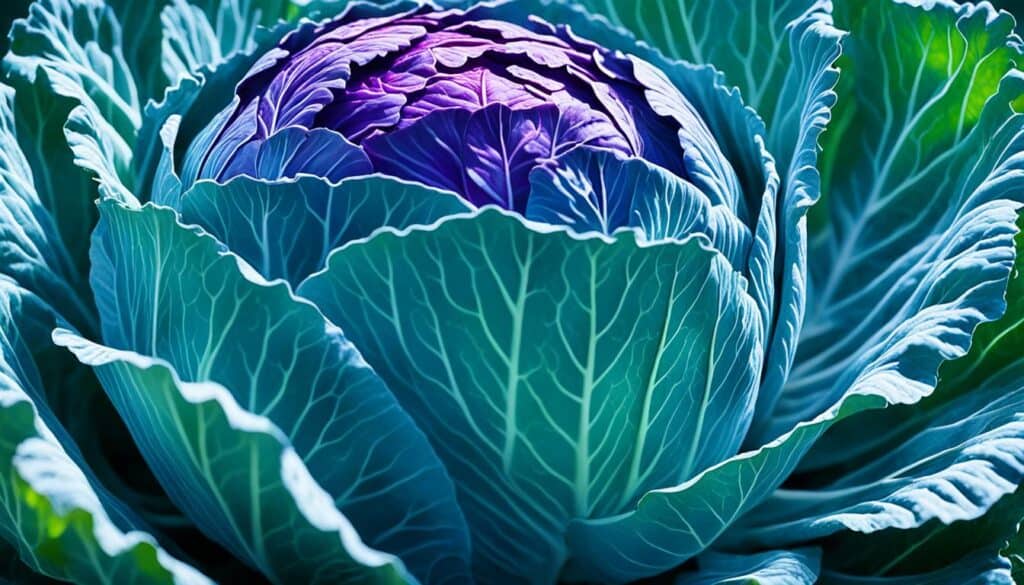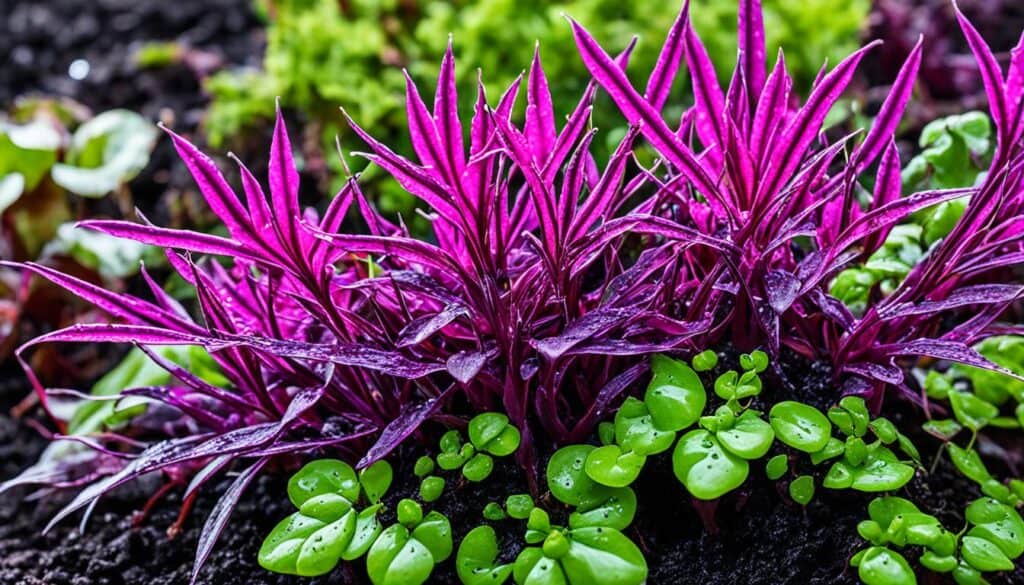Did you know that adding a variety of leafy green vegetables to your diet can have a profound impact on your health? These nutrient-rich vegetables, also known as healthy greens, are not only delicious but also offer an array of benefits that can boost your vitality.
From organic greens and superfoods to salad greens and green vegetables, incorporating these healthy greens into your daily meals and green smoothies can be a game-changer for your overall well-being.
Are you ready to discover the incredible power of these leafy greens? Let’s explore some of my favorite varieties that are not only tasty but also packed with essential vitamins, minerals, and fiber.
Key Takeaways:
- Including a variety of leafy green vegetables in your diet can have a profound impact on your health.
- Healthy greens are nutrient-rich vegetables that offer numerous health benefits.
- From organic greens to superfoods, there are many delicious options to choose from.
- Incorporating leafy greens into your meals and green smoothies can boost your vitality.
- Stay tuned to discover the health benefits of kale, microgreens, collard greens, spinach, cabbage, beet greens, watercress, romaine lettuce, Swiss chard, and more!
Kale – A Nutrient-Dense Powerhouse
Kale, a leafy green vegetable, is a powerhouse of nutrition with an array of vitamins, minerals, and antioxidants. This superfood is packed with vitamin K, vitamin A, and vitamin C, contributing to its many health benefits. The abundance of antioxidants in kale, such as lutein and beta-carotene, helps reduce the risk of diseases caused by oxidative stress.
Did you know? Kale is part of the cruciferous vegetable family, which also includes broccoli, cabbage, and Brussels sprouts.
Whether consumed raw, cooked, or blended in a smoothie, kale provides a wide range of options to incorporate into a healthy diet. To preserve its nutritional value, steaming kale is the recommended cooking method.
The Nutritional Composition of Kale
| Nutrient | Amt per 100g |
|---|---|
| Vitamin K | 817 micrograms |
| Vitamin A | 481 micrograms |
| Vitamin C | 93 milligrams |
| Lutein | 18 milligrams |
| Beta-carotene | 681 micrograms |
Kale’s nutrient composition makes it an excellent addition to a well-balanced diet. By including this leafy green vegetable in your meals, you can support optimal health and enjoy its remarkable benefits.
“Kale is nature’s way of saying, ‘Eat your vitamins!’”
So, whether you enjoy it in a fresh salad, sautéed as a side dish, or incorporated into a delicious green smoothie, make sure to embrace the wonders of kale and reap its incredible health benefits.
Microgreens – Nutrient-Dense Immature Greens
Microgreens are a powerhouse of nutrition, packed with essential vitamins, antioxidants, and health benefits. These nutrient-dense immature greens are produced from the seeds of various vegetables and herbs, making them a versatile and flavorful addition to any meal.
Microgreens are rich in vitamins C, E, and K, providing a concentrated dose of these essential nutrients in their early growth stage. Vitamins C and E act as antioxidants, protecting the body against harmful free radicals and supporting overall immune health. Vitamin K plays a crucial role in blood clotting and helps maintain bone health.
These vibrant greens also contain beneficial phytochemicals like ascorbic acid, β-carotene, and phenolic antioxidants. These compounds have been linked to numerous health benefits, including reducing inflammation, promoting heart health, and preventing chronic diseases.
“Adding microgreens to your meals is an easy and delicious way to elevate the nutritional value of your dishes while adding a burst of freshness and color.”
The versatility of microgreens makes them incredibly easy to incorporate into your daily diet. They can be used as a garnish for salads, sandwiches, and soups or mixed into smoothies and omelets for an extra nutrient boost. Growing microgreens at home is also a fun and rewarding project that allows you to enjoy the freshest greens right in your own kitchen.
Experience the health benefits and culinary delights of microgreens by incorporating these nutrient-dense immature greens into your meals. Let their vibrant colors and exceptional flavors enhance your dishes and provide a nutritional boost that your body will thank you for.
Microgreens Nutrition Overview:
| Microgreen Variety | Nutrients |
|---|---|
| Kale Microgreens | High in vitamins C, K, and E |
| Broccoli Microgreens | Rich in vitamins C, K, and A |
| Radish Microgreens | Good source of vitamins C and E |
| Cilantro Microgreens | Packed with vitamins A, C, and K |
Collard Greens – A Good Source of Calcium and Vitamin K
When it comes to nutrient-rich leafy greens, collard greens are an excellent choice to include in your diet. Not only are they delicious, but they also offer a wide range of health benefits. Collard greens belong to the Brassica family, which also includes broccoli, kale, and cabbage.
An important standout feature of collard greens is their high calcium content. Calcium is an essential mineral for maintaining healthy bones and teeth. It also plays a crucial role in muscle function, nerve transmission, and blood clotting. Incorporating collard greens into your meals is an excellent way to boost your calcium intake, especially for individuals following a plant-based diet or those who are lactose intolerant.
Collard greens are also a remarkable source of vitamin K. Vitamin K is known for its role in blood clotting, which is crucial for preventing excessive bleeding. Moreover, vitamin K supports bone health by aiding in the activation of osteocalcin, a protein necessary for bone formation and strength. Including collard greens in your diet can contribute to maintaining optimal bone density and reducing the risk of osteoporosis.
| Nutrient | Amount per 1 cup, cooked (190g) |
|---|---|
| Calcium | 266mg |
| Vitamin K | 1045mcg |
| Vitamin A | 5585IU |
| Vitamin C | 35.3mg |
As shown in the table above, a single cup of cooked collard greens provides a substantial amount of calcium and vitamin K. Additionally, collard greens are packed with vitamin A and vitamin C, which are essential for supporting immune function and maintaining healthy skin.
With their robust flavor and impressive nutritional profile, collard greens are an excellent addition to any meal. Try sautéing them with garlic and olive oil or adding them to soups and stews for a nutritious boost. Don’t let their loose leaves fool you—collard greens are a true powerhouse of calcium and vitamin K, making them a staple for promoting bone health and overall well-being.
Spinach – A Popular and Versatile Leafy Green
When it comes to leafy green vegetables, spinach is a tried and true favorite. This versatile green can be easily incorporated into a variety of dishes, making it a staple in many kitchens. But it’s not just its culinary flexibility that makes spinach so beloved—it’s also packed with a wealth of vitamins, minerals, and health benefits.
One of the key nutrients found in spinach is vitamin K. This essential vitamin plays a crucial role in blood clotting and bone health, making it an important addition to any diet. Spinach is also rich in vitamins A and C, which are known for their antioxidant properties and role in supporting a healthy immune system. Additionally, spinach contains important minerals like manganese and folate, which are essential for various bodily processes.
But it doesn’t stop there. Spinach is also a powerhouse of antioxidants, compounds that help protect the body against damage from harmful free radicals. These antioxidants have been linked to numerous health benefits, including reducing the risk of chronic diseases like heart disease and certain types of cancer.
Furthermore, spinach has been found to aid in red blood cell production, which is essential for carrying oxygen throughout the body. It’s also a great source of folate, a vital nutrient for pregnant women as it helps prevent neural tube defects in developing babies.
To fully appreciate the impressive nutritional profile of spinach, take a look at the table below:
| Nutrient | Amount per 100g |
|---|---|
| Vitamin K | 482.9 mcg |
| Vitamin A | 469.5 mcg |
| Vitamin C | 28.1 mg |
| Manganese | 0.9 mg |
| Folate | 194 mcg |
With its wide range of vitamins, minerals, and health benefits, it’s no wonder why spinach continues to be a popular choice for those seeking to improve their overall well-being. From salads to smoothies, soups to stir-fries, there are countless ways to incorporate this nutritious leafy green into your meals for a delicious and healthful boost.
Cabbage – A Cancer-Protective Vegetable
I’m excited to share with you the amazing health benefits of cabbage, a cruciferous vegetable that deserves a spot in your daily meals. Cabbage is not only delicious but also offers a range of nutrients that can support your overall well-being.
One of the standout features of cabbage is its high concentration of glucosinolates. These compounds are known for their cancer-protective properties, making cabbage a valuable addition to a cancer-preventive diet.
But that’s not all! Cabbage can be transformed into sauerkraut through the fermentation process. This traditional food preparation technique not only enhances the flavor of cabbage but also provides additional health benefits.
Fermented cabbage, or sauerkraut, is rich in probiotics, which promote a healthy gut microbiome and aid digestion. Additionally, sauerkraut contains live enzymes and antioxidants that can help reduce inflammation in the body and support the immune system.
Why Choose Cabbage?
Cancer Protection: Cabbage’s glucosinolates have been found to have cancer-preventive effects, particularly against colon and bladder cancer. Including cabbage in your diet can potentially reduce your risk of developing these types of cancers.
Health Benefits: In addition to cancer protection, cabbage offers a range of health benefits. It is a good source of vitamins C and K, as well as fiber, which can promote healthy digestion and support heart health.
Versatility: Cabbage can be enjoyed raw in salads, cooked in stir-fries and soups, or fermented into sauerkraut. Its mild, slightly sweet flavor makes it a versatile ingredient in a variety of dishes.
Let’s Get Cooking!
Now that we’ve explored the health benefits of cabbage, it’s time to incorporate it into our meals. Here’s a simple recipe to try:
- Make a refreshing coleslaw by combining shredded cabbage, grated carrots, and a tangy dressing made from lemon juice, olive oil, and a touch of honey.
- Create a hearty cabbage soup by simmering cabbage with onions, carrots, celery, and vegetable broth. Season with herbs and spices of your choice for added flavor.
- Experiment with fermented cabbage and make your own sauerkraut at home. Simply shred cabbage, mix it with salt, and let it ferment in a jar for a few days. Enjoy the tangy and probiotic-rich sauerkraut as a side dish or topping for sandwiches.
By incorporating cabbage into your meals, you can reap its cancer-protective benefits and boost your overall health. So, let’s get creative in the kitchen and experience the incredible flavors and health benefits of this versatile vegetable!
Beet Greens – The Nutrient-Rich Leaves of Beets
When it comes to leafy greens, beet greens are a hidden gem that shouldn’t be overlooked. These edible leaves are not only delicious but also packed with essential vitamins and antioxidants that offer a range of health benefits.
Beet greens are a fantastic source of vitamins K, A, and C. Vitamin K is crucial for blood clotting and bone health, while vitamins A and C support immune function and promote collagen production for healthy skin.
But that’s not all – beet greens also contain antioxidants such as zeaxanthin and lutein. These antioxidants have been linked to promoting eye health by reducing the risk of age-related macular degeneration and cataracts.
To reap the health benefits of beet greens, there are various ways to incorporate them into your meals. You can add chopped beet greens to salads for a nutrient boost, use them in soups for added flavor and texture, or sauté them as a delicious side dish.
However you choose to enjoy them, beet greens are a fantastic addition to any diet. Their rich nutrient profile and eye-protective antioxidants make them a valuable component of a healthy lifestyle.
Vitamins and Antioxidants in Beet Greens
| Nutrient | Amount per 100g |
|---|---|
| Vitamin K | 500 mcg |
| Vitamin A | 1177 IU |
| Vitamin C | 30 mg |
| Zeaxanthin | 451 mcg |
| Lutein | 300 mcg |
Watercress – A Healing Aquatic Herb
Watercress is an aquatic plant similar to arugula and mustard greens. It is said to have healing properties and contains vitamins C, A, and K. Watercress makes a great addition to neutrally flavored foods.
One of the unique characteristics of watercress is its ability to grow in running water, which makes it an aquatic plant. This vibrant green herb is often found near clear streams and is known for its fresh and peppery flavor.
Watercress is not only delicious but also packed with essential vitamins and minerals that contribute to overall well-being. Let’s take a closer look at the health benefits of this aquatic plant:
| Vitamins | Health Benefits |
|---|---|
| Vitamin C | – Boosts immune system – Supports collagen production for healthy skin – Acts as an antioxidant to protect cells from damage |
| Vitamin A | – Promotes good vision – Supports immune function – Maintains healthy skin and mucous membranes |
| Vitamin K | – Essential for blood clotting – Supports bone health and metabolism |
Adding watercress to your diet is a simple and effective way to incorporate nutrient-rich greens. Its unique flavor profile makes it a versatile ingredient that can be used in various dishes. You can enjoy watercress in salads, sandwiches, soups, or even as a garnish for your favorite dishes.
“Watercress has a distinct peppery taste that adds a refreshing kick to my salads. I love knowing that I’m getting a boost of vitamins and minerals with each bite!” – Sarah, watercress enthusiast
Whether you’re looking to amp up the flavor of your meals or reap the health benefits of this aquatic herb, watercress is definitely worth a try. Start exploring creative recipes and enjoy the vibrant taste and nutritional goodness that watercress brings to your plate.
Romaine Lettuce – A Crunchy and Nutrient-Rich Leafy Vegetable
When it comes to leafy greens, romaine lettuce is a popular and versatile choice. With its sturdy dark leaves and satisfying crunch, romaine lettuce adds texture and flavor to a variety of dishes. But its appeal goes beyond taste and texture – romaine lettuce is a nutritional powerhouse packed with vitamins and health benefits.
Romaine lettuce is an excellent source of vitamins A and K. Vitamin A plays a crucial role in maintaining healthy vision, promoting a strong immune system, and supporting the growth and development of cells throughout the body. Meanwhile, vitamin K is essential for blood clotting and bone health, making it an important nutrient for overall well-being.
One of the remarkable health benefits of romaine lettuce is its potential to regulate blood sugar and insulin levels. The high fiber content in romaine lettuce helps slow down the absorption of sugar in the bloodstream, resulting in more stable blood sugar levels. This makes romaine lettuce an excellent choice for individuals looking to maintain healthy blood sugar regulation.
Whether you enjoy it as part of a refreshing salad or use it as a lettuce wrap in place of bread, romaine lettuce offers a range of delicious possibilities. Its crisp texture and mild flavor make it a versatile ingredient that pairs well with various toppings, dressings, and fillings.
Next time you craft a salad or wrap, consider incorporating romaine lettuce for its nutritional value and health-boosting properties.
Summary:
Romaine lettuce is a nutritious leafy green vegetable rich in vitamins A and K. Its high fiber content contributes to the regulation of blood sugar levels, making it a valuable addition to a healthy diet. Incorporate romaine lettuce into your meals for a crunchy and nutrient-packed experience.
| Health Benefits of Romaine Lettuce |
|---|
| 1. Excellent source of vitamins A and K |
| 2. May help regulate blood sugar and insulin levels |
| 3. Provides a satisfying crunch and mild flavor |
| 4. Versatile ingredient for salads and wraps |
Include romaine lettuce in your diet to reap its nourishing benefits and enjoy a delicious and nutritious addition to your meals.
Swiss Chard – A Flavorful and Nutrient-Packed Green
When it comes to nutrient-rich greens, Swiss chard is a standout star. With its dark green leaves and thick stalk, this leafy vegetable offers a plethora of vitamins and minerals that contribute to overall health and well-being.
One of the key benefits of Swiss chard is its impressive vitamin content. It is a great source of vitamins A, C, and K, which play crucial roles in maintaining healthy vision, supporting the immune system, and promoting blood clotting, respectively. Additionally, Swiss chard is packed with magnesium, a vital mineral that helps regulate blood pressure, strengthen bones, and support energy production.
But Swiss chard doesn’t stop there. It also contains a unique compound called syringic acid, which has been linked to potential benefits for blood sugar regulation. This compound may help lower blood sugar levels, making Swiss chard a valuable addition to the diet for those managing diabetes or looking to improve their overall blood sugar control.
When it comes to incorporating Swiss chard into your meals, the possibilities are endless. You can enjoy it in flavorful soups, stir-fries, or even as a delicious filling for tacos. Its versatility and nutritional profile make it a fantastic choice for those looking to add more variety and health benefits to their meals.
| Nutrients | Amount per 1 cup (36g) of Swiss Chard |
|---|---|
| Calories | 7 |
| Carbohydrates | 1.4 grams |
| Protein | 0.6 grams |
| Fiber | 0.6 grams |
| Vitamin A | 214% of the Daily Value (DV) |
| Vitamin C | 53% of the DV |
| Vitamin K | 716% of the DV |
| Magnesium | 29% of the DV |
With its rich nutritional profile and potential health benefits, Swiss chard is certainly a green worth incorporating into your diet. Whether you’re looking to boost your vitamin intake, support blood sugar control, or simply add more flavor to your meals, Swiss chard is a flavorful and nutrient-packed choice that can contribute to your overall well-being.
Conclusion
In conclusion, incorporating a variety of healthy greens into your diet is essential for maintaining vitality and reaping the numerous health benefits they offer. Leafy green vegetables are powerhouses of important nutrients that promote overall well-being. From nutrient-rich kale and versatile spinach to calcium-rich collard greens and antioxidant-packed microgreens, there is a wide range of nutritious vegetables to choose from.
By experimenting with different recipes and cooking methods, you can enjoy the full range of flavors and nutritional benefits that these leafy greens provide. Whether you prefer raw salads, cooked dishes, or green smoothies, adding healthy greens to your meals will not only enhance the taste but also contribute to your overall health.
Including a variety of leafy greens in your diet can help reduce the risk of obesity, heart disease, high blood pressure, and mental decline. Moreover, their high content of vitamins, minerals, and fiber makes them an important part of a healthy eating regimen. So make sure to incorporate these nutritious vegetables into your daily meals and enjoy the positive impact they have on your vitality and well-being.










Leave a Reply